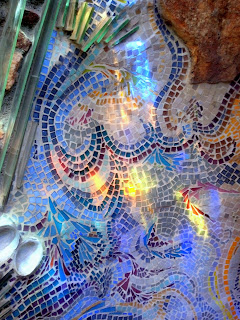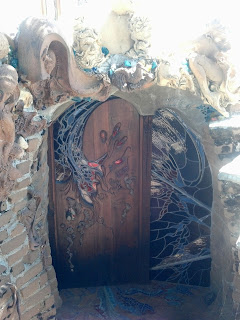Thursday, April 18, 2013
I am in love with Jame Hubble's work. He is an artist and a cultural icon here in San Diego. Building his home by hand with his family using rocks and trees on his land in Julian he has created a beautiful space of hope and inspiration.
He is the founder of Ilan Lael foundation. He hosts Conversations of Beauty at the Mengei Museum in SD Balboa park every month. He is also the designer of a beautiful school, La Esperanza , built in the middle of an incredibly poor part of TJ.
He is soft spoken but when he does speak he evokes an intent concentration from everyone around him. You listen absorbing every word of simple wisdom he has to share and you feel better for it. I have learned from him that beauty and art make people fall in love with a space, with the land, with cultural institutions, schools, playgrounds and places that give purpose and hope and make us want to cherish and preserve our culture. I encourage everyone in SD to come visit his home or listen to him speak at the Mengei.
Saturday, July 2, 2011
Art Fundraiser for Natives in Peru
Thanks to everyone who bought the natural art art and helped contribute 15% to Nawpa Runa. Even a little bit of money helps put them closer to publishing the traditional medicinal book which will cost around $700-1000 but help bring in a lot of money to preserve the traditional arts and knowledge of the native community in Chazuta here in Northern Peru.
Friday, May 27, 2011
Art from the Amazon
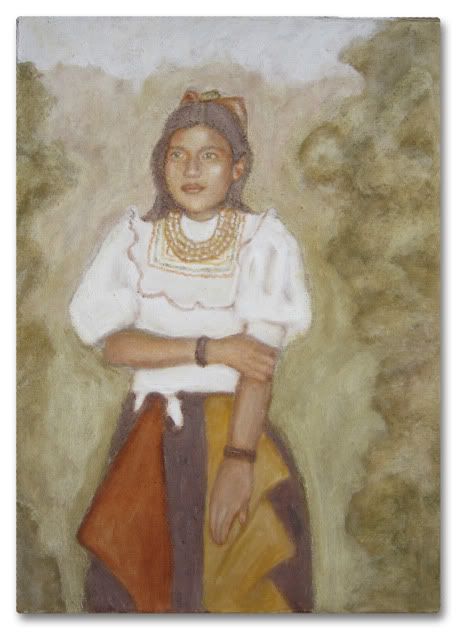 Warmista Bonita
Warmista Bonitaon canvas
50.5 x 70 cm
 Abuela en el Castillo de Lamas
Abuela en el Castillo de Lamas25 x 35 cm
SOLD
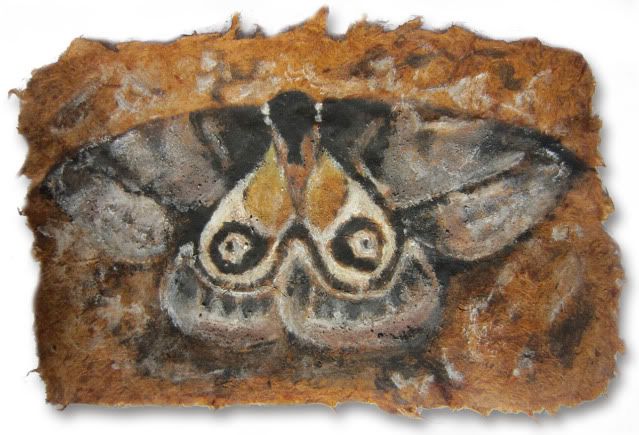 Polilla de la Noche
Polilla de la Noche23 x 14 cm
SOLD
via Trueque in exchange for some
handmade pottery and donation to Nawpa Runa
 Niño Curioso, Chazuta
Niño Curioso, Chazuta14 x 23 cm
SOLD
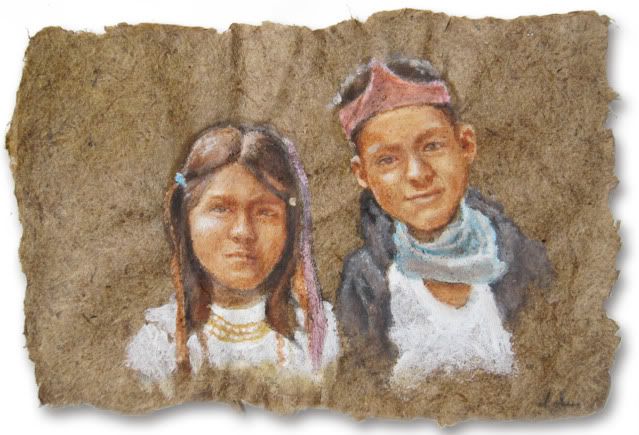 Maribelle y su Hermano de Comunidad Nativa Chunchihui
Maribelle y su Hermano de Comunidad Nativa Chunchihui50.5 x 70 cm
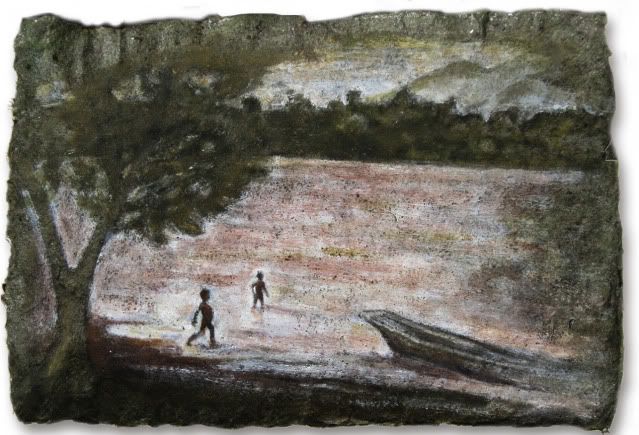 Niños en el Rio Huallaga, Chazuta
Niños en el Rio Huallaga, Chazuta47 x 32 cm
SOLD
 Sabiduria Lamista on canvas
Sabiduria Lamista on canvas28.5 x 36 cm
SOLD
*prices don't include shipping from CA
Art in progress and details shots

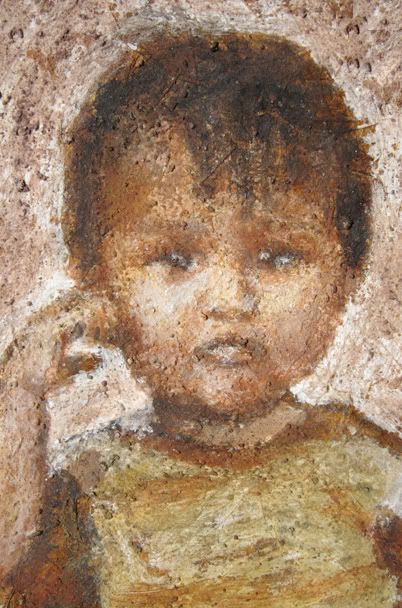



I collected the rocks from a local river. The rocks are hand crushed and added to a binder to make paint. They are minerals and won't biodegrade or fade like plant colors. The banana paper is made by local women and this too will last just like any other paper. Of course, like any piece of art, be careful to keep out of direct sunlight.
As a new medium, there was a definate learning curve for me. Especially because some paint on very light or clear then dry much darker. I had to use many layers and wait for them to dry to see the results. The paint encouraged me to learn to paint in a new way.
The images of the paintings are done from photos that I took in the area and some are from a local professional photographer, Javier Quintana.

Trina, the founder of Sachaqa Centro de Arte, taught herself this technique of paint making and is now selling her natural pigment paints here
Some Thoughts
 My airy loft/studio where the occasional giant deadly tarantula fell from the ceiling..no big deal.
My airy loft/studio where the occasional giant deadly tarantula fell from the ceiling..no big deal.One of the things my painting teacher, Lela Harty, told me when I picked up my first oil paints was that you can make art with a stick and mud if you know what you are doing. Well almost ten years later perhaps I can see it as a right of passage that I have literally accomplished this feat. Below is a series of paintings created out of natural paints made from clay rocks, picked from the waters of the Huallaga River in Northern Highland Amazon Jungle of Peru. They are hand crushed and applied to local handmade banana paper. A local artist, Trina Brammah, showed me where to find and create these paints myself. Trina also founded the sustainable Art Center Sachaqa that I have been working in.
My travels to get where I am now have been a journey of self discovery and revelation that will carry me to my future to come. For almost a year now I have been trekking sola from Colombia, through Ecuador to Peru, searching out alternative ways of living, building, thinking, being. I see the town I am in now, San Roque, as a wonderful rest point that has brought together my thoughts and skills attained on this search. Here I have been working full time to help build two houses using the local indigenous method of dried mud called Quincha. I also traveled to local farms to help with coffee harvesting.
In my spare time I have been experimenting with the local natural paints. My residence is a bamboo and leaf house at a spiritual center called Hunab-Ku. Here there is ample time to realize my ideals of acceptance, non-attachment, intuition, being, curiosity and excitment about life. A mix of strong community, connection to the land, and respect for nature makes this a fufilling environment. My days are full but I have never felt rushed through my tasks. I feel I have time, cook healthy meals, read, paint, sleep, hike and all the while ot seems as if I am just hanging out with friends and together we are helping each other manifest the life we envision. Returning to this mindset has reminded me of a natural flow and continuity in life can be achieved no matter where I am. Wise friends have told me, when you are in the right place, reaching your potential just flows and your goals are manifested, not perhaps without effort but without struggle. Everyday I feel I get closer to being in this right place.
The paintings themselves are a manifestation of my desire to create beauty that is derived more directly from nature. To see where all the materials come from and know they will go back someday not harming but enriching the earth. The colors of the river match the skin tones of the people here a reminder to me that we are all made of the same thing, we are all the same.
I am mailing my paintings home and selling my painting to help donate a portion to the Ñawpa Runa Foundation who supports the continuation of local art traditions such as pottery and paper making. Nawpa Runa has just started a project to create a book to share ancient medicinal plant knowledge. A medical student I met agreed to study under a woman in the region to learn and translate her knowledge into a book. I hope to help do the design and the proceeds made from the art will go to help publish the book.. If one piece speaks to you and you cannot pay I am open to Trueque (an exchange of goods, services or knowledge).
I hope you enjoy them and everyday find that space to match mind, body, and lifestyle.
Friday, May 20, 2011
Art Exhibition in Peru

Through Sachaqa Art Center I had the great opportunity to show my work in a gallery exhibition here in Lamas, Peru this weekend during the celebration of Corpus Christi. A big festival was held in this cultural town with many of the native people coming to share traditional foods and crafts. I exhibited next to a very well respected local artist Yolanda Racceto. We both had impressionistic paintings of the local people so it was a good combination. I felt that my portraits of the local natives made from natural paints on handmade banana paper was very well received by the people and I was happy with the show.
 With the paintings
With the paintings Daniel who helped me set up the show with his wife Trina, the founder of Sachaqa Art Center on the Left and my friend Jesulyn on the right.
Daniel who helped me set up the show with his wife Trina, the founder of Sachaqa Art Center on the Left and my friend Jesulyn on the right. Yolanda and I. She has lived all over including New York and exhibited in many countries.
Yolanda and I. She has lived all over including New York and exhibited in many countries. The little gringa painting in the street
The little gringa painting in the street It was a little difficult painting with the crowd but the people really seemed to enjoy watching and it was great to the kids so interested in the art.
It was a little difficult painting with the crowd but the people really seemed to enjoy watching and it was great to the kids so interested in the art.

 Another artist Juan who did some chainsaw sculpting...a little more exciting than me!
Another artist Juan who did some chainsaw sculpting...a little more exciting than me!
Saturday, April 30, 2011
Sticks and Mud in San Roque, Peru





Sachaqa Centro de Arte.
I first heard about this area through Trina´s art center. A sustainable artist’s retreat in the amazon, you say? Heck yeah I am going there. Trina, from England, has run the center for over 4 years bringing people from all over to have a beautiful and therapeutic place to practice art. Trina showed me how to make natural paints out of the river rocks, something that has been a dream of mine for a long time.
A new art center was being built as a part of a larger sustainable community. I happened to be very fortunate that they were just beginning to build this and another house out of the traditional local method called Quincha. The exact type of project I had been hoping to get my hands dirty in on my trip.
The Sustainable Community




Quincha
Quincha is a traditional method of using caña brave to make an earthquake-proof frame covered in mud to build a light airy house perfect for the warm humid climate here.
Quincha Recipe:
- A pile of Dirt
- 1/3 water
- rice leaves
- banana palm stems shredded
- Directions: mix all together and mash well with feet.
Long soft bricks can then be made by slapping globs of it into the mud until they are nice and thick. The long bricks are then hung over the caña brava and smoothed into a wall. Once dry another layer of mud and rice leaves is smoothed over. And there your have your eco house. Trina and Daniel hope to have the art center done soon to invite artists to this new site within the community.



Chirapa Manta
Javier and Claudia´s eco center, Chirapa Manta, is the other house we have been building out of mud. Even though it is out of mud, this is pretty luxurious eco-housing. There is a group of people here who are all friends and are striving to start green enterprises like this one to keep San Roque clean and sustainable and also help educate the people of Peru about the importance of our earth.
Javier says: “Here we all are teachers and we learn from everybody, even from the animals and plants... here there is no master, we are all together going through this beautiful adventure…”



Ñawpa Runa Facebook
http://www.nawparuna.org/
Trina´s husband Daniel is very involved in the arts, music, dance and traditions of the area. His Non-profit, Ñawpa Runa aims at preserving the indigenous traditions in ceramic works, handicraft such as: basket weaving, embroidery, knitting and folk dances, as well as the need to preserve the Quechua language. There is a women here with knowledge of local medicinal plants, healing ailments such as, arthritis, rheumatism, infections, intestinal worms, diarrhea, cancer, diabetes etc. She would like to teach people and have help documenting her knowledge. He also strives to teach practical topics in the production of Cacao, Honey, Coffee, Cotton, Beans, Riceon the local farms.
In the culture of these indigeneous people the basic element consists not in “development” but living in “equilibrium” within the numerous ecosystems and the order that exists between species of the great biodiversity that exist in the Amazon region.


Hunab-Ku

The roomy bamboo and thatched roof loft I have been living in is a part of Hunab-Ku, a spiritual center surrounded by a botanical garden with Amazonian medicinal plants. The construction of the center was realized according to the laws of sacred geometry using local and natural materials. I was told also that the elements of construction were meant to bring forth your path and especially for women your intuition. I have to say that I had a lot of vivid dreams here and everyone who slept here said the same .
Shamanism, Ancient wisdom and the Origins of Life
San Roque is known for it’s traditional ayahuasca ceremonies. People from many countries fly here for a weekend just to have a ceremony. " Ayahuasca " is Quechua for "spirit vine" or "vine of the souls". It is a brew of the giant forest plant banisteriopis caapi mixed with psychotria virdis. Brewed for hours together, they have strong hallucinogenic properties that have been historically consumed by the western half of the Amazon valley and isolated tribes on the pacific slopes of the Ecuadorian and Colombian Andes. Unlike San Pedro, which deals more with the outer world of nature, ayahuasca is done at night and taps into cleansing your inner self which can be a terrifying experience revealing and releasing bad energy people hold inside. I have heard many things about the different experiences and revelations of those using ayahuasca as a therapy.
Most are struck immediately by vived hallucinations, some see images of the universe, the earth before life, the veins in their hand as the same as the veins in a leaf, a feeling of connection to all things, a clear vision of who they are, and almost all see terrifuing twisting snakes. They say that the snake is the mother of the ayahuasca .
Much of indigenous mythology claim to have come from auywaska visions as well as their unbelievably complex medicines created without access to modern science. The indiginous say the auywaska revealed many secrets of medicine to them.
A current belief is that somehow the plant allowed shamans to gain acess to biomelecular information. Most the images that appear over an over in indigenous mythology, which comes from ayahuasca visions, can be connected to the discoveries of modern science. According to Jeremy Narby´s book, The cosmic serpent: DNA and the origins of knowedge, imagery of twisting snakes occures over and over in visons and mythology as a symbol of the vital life force that the indiginous believe permeates every living thing. Narby sees this as metaphorical imagery of the double helix of DNA. Often this vital life force is seen as arrivng to earth from another place. An account from anthropologist in Peru during auywaska vision said they saw the world before life and how life came from cosmic origin of twin snakes landing on earth and mutating into many forms. The widley held belief that life spontanelously created itself on earth is also challenged by Francis Crick, co-discoverer of DNA. He wrote in Life Itself: Its origin and nature: That probability of change emergence of a single protein need to create DNA are in the odds of one in 20 to the 200th, this is enormously greater than the number of atoms in the observable universe (estimated at 10to the 80th)- Crick resolves that life “cannot have arisen by pure chance”. This evidence of life emerging from out side of earth struck me as very interesting. Whether or not the twisitng serpants truly represnt an ancient knowledge of DNA and that life came from another place is anybodys guess. However, it is undeniable that the indiginous have a deep understaning that there is a vital life force that connects us all and an incredible knowledge of the medicinal power of plants that cannot be lost.


I talked with many people who have tried these cleanses and all said they found answers to something. It was reveled to a mother who had little time to play with her kids to look in their eyes deeply to make that connection with them. Others todl me stories that they were shown who they were and who they would be which helped greatly on there path of life.
OK mom and dad, before you get scared and think that I am wigging out on strange halluanagenic drugs in the jungle, don’t worry. I haven’t taken any. I feel that my path of enlightenment doesn’t include external medicines at this point in my life but other practices internal in myself. I believe that everyone has their own way and the ancient medicinal plants of the jungle are a fascinating history to learn about.
Indiginous of San Martin area
I have had some really great opportunities to work on some of the local farms and spend time with some indiginous families here. They still speak Quechua, the native dialect, and still tend the land like they have been for centuries. Below is Pantronilla, a Lamista who showed me the traditional technique of making pottery.





Really so much to see and do in San Roque though at first glance a sleepy little town tucked in the jungle. I will have more info on my art with natural paints soon!





